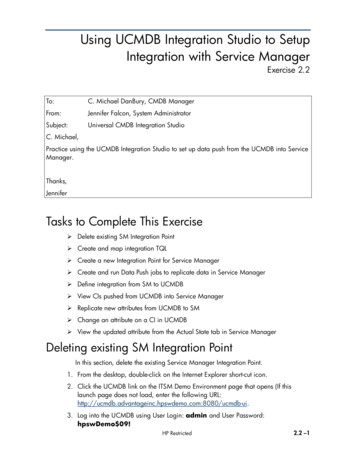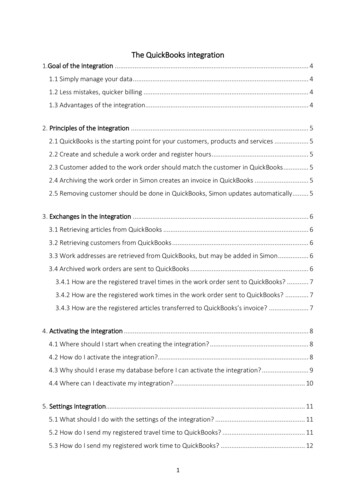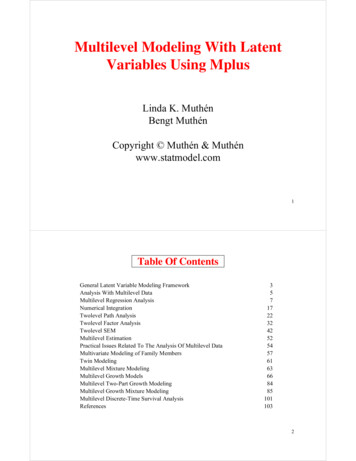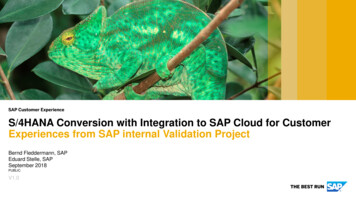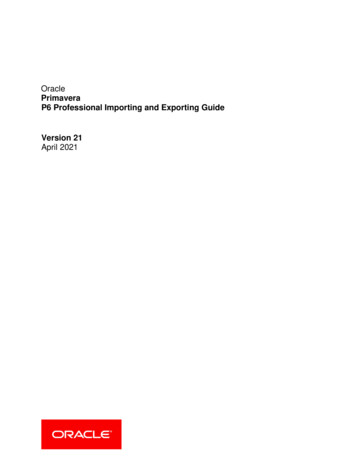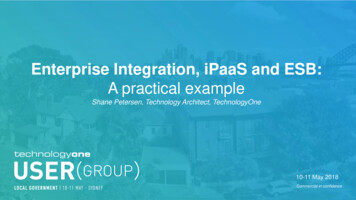![[MS-ISPAC]: Integration Services Project Deployment File Format - Microsoft](/img/53/ms-ispac.jpg)
Transcription
[MS-ISPAC]:Integration Services Project Deployment File FormatIntellectual Property Rights Notice for Open Specifications Documentation Technical Documentation. Microsoft publishes Open Specifications documentation (“thisdocumentation”) for protocols, file formats, data portability, computer languages, and standardssupport. Additionally, overview documents cover inter-protocol relationships and interactions.Copyrights. This documentation is covered by Microsoft copyrights. Regardless of any otherterms that are contained in the terms of use for the Microsoft website that hosts thisdocumentation, you can make copies of it in order to develop implementations of the technologiesthat are described in this documentation and can distribute portions of it in your implementationsthat use these technologies or in your documentation as necessary to properly document theimplementation. You can also distribute in your implementation, with or without modification, anyschemas, IDLs, or code samples that are included in the documentation. This permission alsoapplies to any documents that are referenced in the Open Specifications documentation.No Trade Secrets. Microsoft does not claim any trade secret rights in this documentation.Patents. Microsoft has patents that might cover your implementations of the technologiesdescribed in the Open Specifications documentation. Neither this notice nor Microsoft's delivery ofthis documentation grants any licenses under those patents or any other Microsoft patents.However, a given Open Specifications document might be covered by the Microsoft OpenSpecifications Promise or the Microsoft Community Promise. If you would prefer a written license,or if the technologies described in this documentation are not covered by the Open SpecificationsPromise or Community Promise, as applicable, patent licenses are available by contactingiplg@microsoft.com.License Programs. To see all of the protocols in scope under a specific license program and theassociated patents, visit the Patent Map.Trademarks. The names of companies and products contained in this documentation might becovered by trademarks or similar intellectual property rights. This notice does not grant anylicenses under those rights. For a list of Microsoft trademarks, visitwww.microsoft.com/trademarks.Fictitious Names. The example companies, organizations, products, domain names, emailaddresses, logos, people, places, and events that are depicted in this documentation are fictitious.No association with any real company, organization, product, domain name, email address, logo,person, place, or event is intended or should be inferred.Reservation of Rights. All other rights are reserved, and this notice does not grant any rights otherthan as specifically described above, whether by implication, estoppel, or otherwise.Tools. The Open Specifications documentation does not require the use of Microsoft programmingtools or programming environments in order for you to develop an implementation. If you have accessto Microsoft programming tools and environments, you are free to take advantage of them. CertainOpen Specifications documents are intended for use in conjunction with publicly available standardsspecifications and network programming art and, as such, assume that the reader either is familiarwith the aforementioned material or has immediate access to it.Support. For questions and support, please contact dochelp@microsoft.com.1 / 23[MS-ISPAC] - v20191016Integration Services Project Deployment File FormatCopyright 2019 Microsoft CorporationRelease: October 16, 2019
Revision /20100.1NewReleased new document.2/9/20110.1NoneNo changes to the meaning, language, or formatting of thetechnical content.7/7/20111.0MajorUpdated and revised the technical content.11/3/20111.0NoneNo changes to the meaning, language, or formatting of thetechnical content.1/19/20121.0NoneNo changes to the meaning, language, or formatting of thetechnical content.2/23/20121.0NoneNo changes to the meaning, language, or formatting of thetechnical content.3/27/20121.0NoneNo changes to the meaning, language, or formatting of thetechnical content.5/24/20121.0NoneNo changes to the meaning, language, or formatting of thetechnical content.6/29/20121.0NoneNo changes to the meaning, language, or formatting of thetechnical content.7/16/20121.0NoneNo changes to the meaning, language, or formatting of thetechnical content.10/8/20121.0NoneNo changes to the meaning, language, or formatting of thetechnical content.10/23/20121.0NoneNo changes to the meaning, language, or formatting of thetechnical content.3/26/20131.0NoneNo changes to the meaning, language, or formatting of thetechnical content.6/11/20131.0NoneNo changes to the meaning, language, or formatting of thetechnical content.8/8/20131.0NoneNo changes to the meaning, language, or formatting of thetechnical content.12/5/20131.0NoneNo changes to the meaning, language, or formatting of thetechnical content.2/11/20142.0MajorUpdated and revised the technical content.5/20/20142.0NoneNo changes to the meaning, language, or formatting of thetechnical content.5/10/20163.0MajorSignificantly changed the technical content.8/16/20174.0MajorSignificantly changed the technical content.10/16/20195.0MajorSignificantly changed the technical content.2 / 23[MS-ISPAC] - v20191016Integration Services Project Deployment File FormatCopyright 2019 Microsoft CorporationRelease: October 16, 2019
Table of Contents1Introduction . 41.1Glossary . 41.2References . 41.2.1Normative References . 41.2.2Informative References . 51.3Overview . 51.4Relationship to Protocols and Other Structures . 51.5Applicability Statement . 51.6Versioning and Localization . 51.7Vendor-Extensible Fields . 52Structures . 62.1Project Deployment File . 62.2IS Package . 62.3Project Manifest . 62.3.1XML Namespace . 62.3.2Properties . 62.3.3Property . 72.3.4Project . 72.3.5Packages . 82.3.6Package . 92.3.7ConnectionManagers . 92.3.8ConnectionManager . 102.3.9DeploymentInfo. 102.3.10PackageInfo . 102.3.11PackageMetadata. 112.3.12Parameters . 122.3.13Parameter . 123Structure Examples . 144Security . 184.1Security Considerations for Implementers . 184.2Index of Security Fields . 185Appendix A: XML Schema Definition . 196Appendix B: Product Behavior . 217Change Tracking . 228Index . 233 / 23[MS-ISPAC] - v20191016Integration Services Project Deployment File FormatCopyright 2019 Microsoft CorporationRelease: October 16, 2019
1IntroductionThe Integration Services Project Deployment file format is the file format for the Microsoft SQL ServerIntegration Services project deployment file. This file is a file type that is used to represent thepackaged metadata of a data integration project.Sections 1.7 and 2 of this specification are normative. All other sections and examples in thisspecification are informative.1.1GlossaryThis document uses the following terms:globally unique identifier (GUID): A term used interchangeably with universally uniqueidentifier (UUID) in Microsoft protocol technical documents (TDs). Interchanging the usage ofthese terms does not imply or require a specific algorithm or mechanism to generate the value.Specifically, the use of this term does not imply or require that the algorithms described in[RFC4122] or [C706] must be used for generating the GUID. See also universally uniqueidentifier (UUID).Integration Services (IS) package: A module of a project. The module contains control flow anddata flow, as specified in [MS-DTSX].Open Packaging Conventions (OPC) package: A logical entity that holds a collection of parts,as specified in [ISO/IEC29500-2:2008].part: A stream of bytes with a MIME content type and associated common properties, as describedin [ISO/IEC29500-2:2008].project: A collection of Integration Services (IS) packages that are developed and deployed as aunit.project manifest: The metadata that describes the properties of a project as well as its contents.MAY, SHOULD, MUST, SHOULD NOT, MUST NOT: These terms (in all caps) are used as definedin [RFC2119]. All statements of optional behavior use either MAY, SHOULD, or SHOULD NOT.1.2ReferencesLinks to a document in the Microsoft Open Specifications library point to the correct section in themost recently published version of the referenced document. However, because individual documentsin the library are not updated at the same time, the section numbers in the documents may notmatch. You can confirm the correct section numbering by checking the Errata.1.2.1 Normative ReferencesWe conduct frequent surveys of the normative references to assure their continued availability. If youhave any issue with finding a normative reference, please contact dochelp@microsoft.com. We willassist you in finding the relevant information.[FIPS46-2] FIPS PUBS, "Data Encryption Standard (DES)", FIPS PUB 46-2, December 1993,http://my.fit.edu/ gmarin/CSE5636/FIPS46-2DES.htm[MS-DTSX] Microsoft Corporation, "Data Transformation Services Package XML File Format".[RFC2119] Bradner, S., "Key words for use in RFCs to Indicate Requirement Levels", BCP 14, RFC2119, March 1997, http://www.rfc-editor.org/rfc/rfc2119.txt4 / 23[MS-ISPAC] - v20191016Integration Services Project Deployment File FormatCopyright 2019 Microsoft CorporationRelease: October 16, 2019
1.2.2 Informative ReferencesNone.1.3OverviewThis document specifies the file format for the SQL Server Integration Services project deploymentfile, a file type that is used to represent the packaged metadata of a data integration project.The project deployment file is an implementation of Open Packaging Conventions (OPC). The projectdeployment file contains one or more Integration Services (IS) packages and one projectmanifest.Each IS package is represented as one OPC part. The part is uniquely identified by a URI formatterpart name. The part contains an IS package file in the .dtsx file format that is specified in [MS-DTSX].The content type of the part is text/xml.The project manifest is an OPC part of content type text/xml. A project deployment file is required tohave a part that contains the project manifest. The project manifest contains metadata that describesthe project properties, project parameter, and deployment metadata for each of the contained ISpackages.1.4Relationship to Protocols and Other StructuresThe project deployment file format can be used as a payload in protocols that support the transport ofbinary data.1.5Applicability StatementThe project deployment file format is applicable for use in a standalone representation of projectmetadata, for deploying a project from a client to a server, or for extracting a project from a server toa client.1.6Versioning and LocalizationThis document describes version 1.0 of the project deployment file format. There are no localizationdependent structures in the project deployment file format.1.7Vendor-Extensible FieldsExtensions to the file format that is specified in this document are not allowed. Tools that process thisformat do not have to preserve unrecognized structures when loading or persisting.5 / 23[MS-ISPAC] - v20191016Integration Services Project Deployment File FormatCopyright 2019 Microsoft CorporationRelease: October 16, 2019
22.1StructuresProject Deployment FileA project deployment file is an implementation of an Open Packaging Conventions (OPC)package. The file MUST contain the following parts: One part that contains a project manifest. Zero or more parts that contain an IS package.2.2IS PackageAn IS package is stored as one OPC part in the project deployment file. The following rules apply tothe package: The content type of the part MUST be text/xml. The part data stream MUST contain exactly one instance of a file in .dtsx format [MS-DTSX]representing one IS package. The part MUST have a unique part name within the Open Packaging Conventions (OPC)package. The part name URI MUST NOT contain the at sign (@). The part name URI MUST be a root URI; subfolders are not allowed. The part name file name extension MUST be .dtsx.2.3Project ManifestThe project manifest specifies the properties, parameters, and deployment information for aproject. The project manifest is stored as a data stream in an OPC part of the project deploymentfile. The following rules apply to the project manifest: The part name MUST be @Project.manifest. The content type of the part MUST be text/xml.2.3.1 XML NamespaceThe project manifest part contains an XML structure. The namespace URI for the project manifestXML structure is www.microsoft.com/SqlServer/SSIS.2.3.2 PropertiesThe Properties element specifies a list of the Property elements.The following is the child element of the Properties element.Child elementsPropertyThe Properties element schema is specified by the PropertiesType type. The following is the XMLschema definition of the PropertiesType type.6 / 23[MS-ISPAC] - v20191016Integration Services Project Deployment File FormatCopyright 2019 Microsoft CorporationRelease: October 16, 2019
xsd:complexType name "PropertiesType" xsd:choice minOccurs "1" maxOccurs "unbounded" xsd:element name "Property" type "PropertyType"/ /xsd:choice xsd:anyAttribute namespace "##other" processContents "skip" / /xsd:complexType 2.3.3 PropertyThe Property element specifies the value of one property of an object such as a project, an ISpackage, or a parameter.The Property element has a Name attribute of type string that specifies the name of the property.The Property element schema is defined by the PropertyType type. The following is the XMLschema definition of the PropertyType type. xsd:complexType name "PropertyType" xsd:simpleContent xsd:extension base "xsd:string" xsd:attribute name "Name" type "xsd:string" / /xsd:extension /xsd:simpleContent /xsd:complexType 2.3.4 ProjectThe Project element is the root element of the project manifest.The Project element MUST have the following tringSpecifies the protection level of the project. The possible values are as follows: EncryptAllWithUserKey EncryptAllWithPassword EncryptSensitiveWithUserKey EncryptSensitiveWithPassword DontSaveSensitive ServerStorageAll IS packages in the project MUST be serialized by using the same protectionlevel as specified for the project.The following child elements MUST be specified in the Project element.Child elementsPropertiesParametersPackages7 / 23[MS-ISPAC] - v20191016Integration Services Project Deployment File FormatCopyright 2019 Microsoft CorporationRelease: October 16, 2019
Child elementsConnectionManagersDeploymentInfoThe following is the XML schema definition of the Project element. xsd:element name "Project" xsd:complexType xsd:sequence xsd:element name "Properties" type "PropertiesType"minOccurs "1" maxOccurs "1"/ xsd:element name "Parameters" type "ParametersType"minOccurs "1" maxOccurs "1"/ xsd:element name "Packages" type "PackagesType"minOccurs "1" maxOccurs "1"/ xsd:element name "ConnectionManagers" type "ConnectionManagersType"minOccurs "1" maxOccurs "1"/ xsd:element name "DeploymentInfo" type "DeploymentInfoType"minOccurs "1" maxOccurs "1"/ /xsd:sequence xsd:attribute name "ProtectionLevel" type "xsd:string"/ xsd:anyAttribute namespace "##other" processContents "skip" / /xsd:complexType /xsd:element The Project element MUST contain a Properties child element. The Properties child element, inturn, MUST contain a list of Property elements for each Project property that is listed in the fies the GUID that is assigned to the project.NameStringSpecifies the name of the project.DescriptionStringSpecifies the description of the project.VersionMajorPositive integerSpecifies the major version of the project.VersionMinorPositive integerSpecifies the minor version of the project.VersionBuildPositive integerSpecifies the build version of the project.VersionCommentsStringSpecifies comments for the version of the project.VersionGUIDGuidSpecifies the GUID of the version of the project.CreationDateDateTimeOffsetSpecifies the date, time, and time zone offset of the time when theproject was created.2.3.5 PackagesThe Packages element specifies an ordered list of Package elements. The Packages element MUSTcontain a child Package element for each IS package in the project deployment file.The following is the child element of the Packages element.8 / 23[MS-ISPAC] - v20191016Integration Services Project Deployment File FormatCopyright 2019 Microsoft CorporationRelease: October 16, 2019
Child elementsPackageThe Packages element schema is specified by the PackagesType type. The following is the XMLschema definition of the PackagesType type. xsd:complexType name "PackagesType" xsd:choice minOccurs "0" maxOccurs "unbounded" xsd:element name "Package" type "PackageType" / /xsd:choice xsd:anyAttribute namespace "##other" processContents "skip" / /xsd:complexType 2.3.6 PackageThe Package element specifies an IS package that is included in the project deployment file.The Package element MUST have the following anSpecifies whether the IS package is a project entry point for execution. Possible valuesare:1 – The IS package is an entry point.0 – The IS package is not an entry point.NameStringSpecifies the name of the IS package. This name MUST match the part name of thecorresponding OPC part.The Package element schema is specified by the PackageType type. The following is the XMLschema definition of the PackageType type. xsd:complexType name "PackageType" xsd:attribute name "EntryPoint" type "xsd:boolean" / xsd:attribute name "Name" type "xsd:string" / /xsd:complexType 2.3.7 ConnectionManagersThe ConnectionManagers element specifies an ordered list of ConnectionManager elements. AConnectionManager element MUST exist for each connection manager (.conmgr) file that exists inthe project deployment file.The following is the child element of the ConnectionManagers element.Child elementsConnectionManagerThe ConnectionManagers element schema is specified by the ConnectionManagersType type. Thefollowing is the XML schema definition of the ConnectionManagersType type. xsd:complexType name "ConnectionManagersType" xsd:choice minOccurs "0" maxOccurs "unbounded" 9 / 23[MS-ISPAC] - v20191016Integration Services Project Deployment File FormatCopyright 2019 Microsoft CorporationRelease: October 16, 2019
xsd:element name "ConnectionManager" type "ConnectionManagerType" / /xsd:choice xsd:anyAttribute namespace "##other" processContents "skip" / /xsd:complexType 2.3.8 ConnectionManagerThe ConnectionManager element specifies an IS connection manager that is included in the projectdeployment file.The ConnectionManager element MUST have the following fies the name of the IS connection manager. This name MUST match the part name ofthe corresponding OPC part. xsd:complexType name "ConnectionManagerType" xsd:attribute name "Name" type "xsd:string" / /xsd:complexType 2.3.9 DeploymentInfoThe DeploymentInfo element is an ordered list of PackageInfo elements. A PackageInfo elementMUST be specified for each IS package that is included in the project.The following is the child element of the DeploymentInfo element.Child elementsPackageInfoThe DeploymentInfo element schema is specified by the DeploymentInfoType type. The followingis the XML schema definition of the DeploymentInfoType type. xsd:complexType name "DeploymentInfoType" xsd:choice minOccurs "0" maxOccurs "unbounded" xsd:element name "PackageInfo" type "PackageInfoType"/ /xsd:choice xsd:anyAttribute namespace "##other" processContents "skip" / /xsd:complexType 2.3.10 PackageInfoThe PackageInfo element contains the metadata for an IS package that is contained in a project. ThePackageInfo element MUST specify exactly one PackageMetadata element.The following is the child element of the PackageInfo element.Child elementsPackageMetadataThe PackageInfo element schema is specified by the PackageInfoType type. The following is theXML schema definition of the PackageInfoType type.10 / 23[MS-ISPAC] - v20191016Integration Services Project Deployment File FormatCopyright 2019 Microsoft CorporationRelease: October 16, 2019
xsd:complexType name "PackageInfoType" xsd:sequence xsd:element name "PackageMetadata" type "PackageMetadataType"minOccurs "1" maxOccurs "1"/ /xsd:sequence xsd:anyAttribute namespace "##other" processContents "skip" / /xsd:complexType 2.3.11 PackageMetadataThe PackageMetadata element contains the metadata for an IS package contained in the project,including the core IS package properties and the IS package parameters.The PackageMetadata element MUST specify the following ies the name of the IS package. This name MUST match the part name of thecorresponding OPC part.The PackageMetadata element MUST specify the following child elements.Child elementsPropertiesParametersThe PackageMetadata element schema is specified by the PackageMetadataType type. Thefollowing is the XML schema definition of the PackageMetadataType type. xsd:complexType name "PackageMetadataType" xsd:sequence xsd:element name "Properties" type "PropertiesType"minOccurs "1" maxOccurs "1"/ xsd:element name "Parameters" type "ParametersType"minOccurs "1" maxOccurs "1"/ /xsd:sequence xsd:anyAttribute namespace "##other" processContents "skip" / /xsd:complexType The PackageMetadata element MUST contain a Properties child element. The Properties childelement, in turn, MUST contain a list of Property elements for each PackageMetadata property thatis listed in the following table.PropertyValueDescriptionIDGuidSpecifies the GUID that is assigned to the IS package.NameStringSpecifies the name of the IS package.DescriptionStringSpecifies the description of the IS package.ProtectionLevelIntegerSpecifies an integer value. The possible values are as follows.0 – DontSaveSensitive1 – EncryptAllWithPassword2 – EncryptAllWithUserKey11 / 23[MS-ISPAC] - v20191016Integration Services Project Deployment File FormatCopyright 2019 Microsoft CorporationRelease: October 16, 2019
PropertyValueDescription3 – EncryptSensitiveWithPassword4 – EncryptSensitiveWithUserKey5 – ServerStorageVersionMajorPositive integerSpecifies the major version of the IS package.VersionMinorPositive integerSpecifies the minor version of the IS package.VersionBuildPositive integerSpecifies the build version of the IS package.VersionCommentsStringSpecifies comments of the version of the IS package.VersionGUIDGuidSpecifies the GUID of the version of the IS package.2.3.12 ParametersThe Parameters element specifies an ordered list of Parameter elements that declare the parametersof a project or an IS package.The following is the child element of the Parameters element.Child elementsParameterThe Parameters element schema is specified by the ParametersType type. The following is the XMLschema definition of the ParametersType type. xsd:complexType name "ParametersType" xsd:choice minOccurs "0" maxOccurs "unbounded" xsd:element name "Parameter" type "ParameterType"/ /xsd:choice xsd:anyAttribute namespace "##other" processContents "skip" / /xsd:complexType 2.3.13 ParameterThe Parameter element specifies one parameter of a project or an IS package.The Parameter element MUST have the following ies the name of the parameter.The following is the child element of the Parameter element.Child elementsPropertiesThe Parameter element schema is specified by the ParameterType type. The following is the XMLschema definition of the ParameterType type.12 / 23[MS-ISPAC] - v20191016Integration Services Project Deployment File FormatCopyright 2019 Microsoft CorporationRelease: October 16, 2019
xsd:complexType name "ParameterType" xsd:choice minOccurs "0" maxOccurs "unbounded" xsd:element name "Properties" type "PropertiesType"/ /xsd:choice xsd:anyAttribute namespace "##other" processContents "skip" / /xsd:complexType The Parameter element MUST contain a Properties child element. The Properties child element, inturn, MUST contain a list of Property elements for each Parameter property that is listed in thefollowing table.PropertyValueDescriptionIDGuidSpecifies the GUID that is assigned to the parameter.DescriptionStringSpecifies the description of the parameter.RequiredBooleanSpecifies whether the value is required.SensitiveDefaultValueBooleanString True specifies that the parameter is required. False specifies that the parameter is not required.Specifies whether the value is sensitive. True specifies that the parameter is sensitive. False specifies that the parameter is not sensitive.Specifies the serialized value of the parameter.If the project protection level is EncryptSensitiveWithPassword orEncryptSensitiveWithUserKey, the value MUST be encrypted by using a triple DataEncryption Standard (DES) encryption algorithm [FIPS46-2] that uses thecorresponding encryption key. The encrypted value then MUST be encoded by usingbase64 encoding.DataTypeIntegerSpecifies the data type. The possible values are as follows.3 – Boolean5 – SByte6 - Byte9 – Int3210 – Uint3211 – Int6412 – Uint6413 – Single14 – Double16 – DateTime18 – String13 / 23[MS-ISPAC] - v20191016Integration Services Project Deployment File FormatCopyright 2019 Microsoft CorporationRelease: October 16, 2019
3Structure ExamplesThe following is an example of a typical project manifest for a project deployment file, including all themandatory elements and examples of property, parameter, and connection manager declarations. Project ProtectionLevel "EncryptSensitiveWithUserKey" Properties Property Name "ID" {dd0733bd-0382-4511-91d3-ed34210d5469} /Property Property Name "Name" DWLoad /Property Property Name "VersionMajor" 1 /Property Property Name "VersionMinor" 0 /Property Property Name "VersionBuild" 1 /Property Property Name "VersionComments" /Property Property Name "CreationDate" 06/22/2010 01:13:02 -07:00 /Property Property Name "CreatorName" MYDOMAIN\user1 /Property Property Name "CreatorComputerName" MyServer /Property Property Name "OfflineMode" 0 /Property Property Name "Description" /Property /Properties Packages Package Name "MasterControl.dtsx" EntryPoint "1" / Package Name "LoadCustomerDim.dtsx" EntryPoint "1" / Package Name "LoadProductDim.dtsx" EntryPoint "1" / Package Name "LoadSalesFact.dtsx" EntryPoint "1" / Package Name "Cleanup.dtsx" EntryPoint "1" / /Packages Parameters / ConnectionManagers ConnectionManager Name "Love.conmgr" / /ConnectionManagers DeploymentI
The project deployment file format can be used as a payload in protocols that support the transport of binary data. 1.5 Applicability Statement The project deployment file format is applicable for use in a standalone representation of project metadata, for deploying a project from a client to a server, or for extracting a project from a server to
